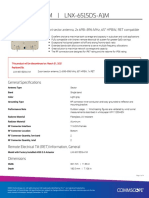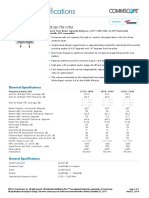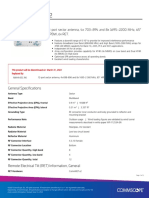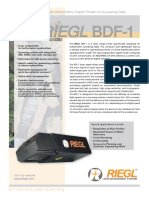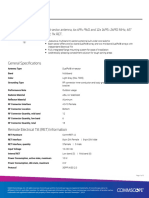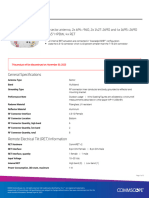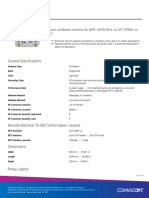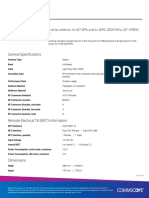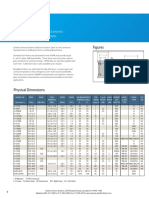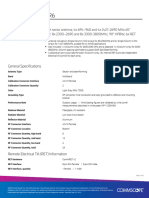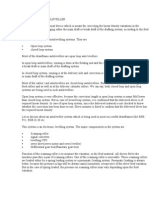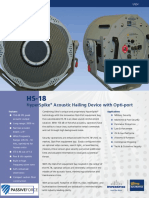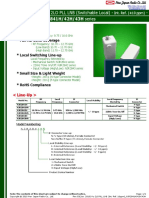Active Antenna System Description AIR 6472 B77G+B77M
Active Antenna System Description AIR 6472 B77G+B77M
Uploaded by
timothy.sCopyright:
Available Formats
Active Antenna System Description AIR 6472 B77G+B77M
Active Antenna System Description AIR 6472 B77G+B77M
Uploaded by
timothy.sCopyright
Available Formats
Share this document
Did you find this document useful?
Is this content inappropriate?
Copyright:
Available Formats
Active Antenna System Description AIR 6472 B77G+B77M
Active Antenna System Description AIR 6472 B77G+B77M
Uploaded by
timothy.sCopyright:
Available Formats
Active Antenna System
description
AIR6472 B77G and B77M
| 2024-03-05 | Commercial in Confidence | Page 1
Revision history
Revision Reason for revision Author
B Minor Updated in Representative Alireza Motevasselian
NF
C Minor Updated in Representative Alireza Motevasselian
NF
D Minor Updated in Representative Alireza Motevasselian
NF
| 2024-03-05 | Commercial in Confidence | Page 2
Downlink broadcast beams
General
● DL broadcast beams can be
Applicable for: NR B77G
configured in the following
different scenarios Scenario Macro Hotspot High-rise
– Macro Horizontal beam-width 65 65 20
– Hotspot Vertical beam-width 5 20 20
Horizontal tilt 0 0 0
– High-rise
Vertical down-tilt +1 to +6 +6
● The table shows +11
fundamental beam-width
and beam-pointing
characteristics for the
different scenarios
| 2024-03-05 | Commercial in Confidence | Page 3
Downlink broadcast beams
General
● DL broadcast beams can be
Applicable for: NR B77M
configured in the following
different scenarios Scenario Macro Hotspot High-rise
– Macro Horizontal beam-width 65 65 20
– Hotspot Vertical beam-width 4.5 18 18
Horizontal tilt 0 0 0
– High-rise
Vertical down-tilt +1 to +6 +6
● The table shows +11
fundamental beam-width
and beam-pointing
characteristics for the
different scenarios
| 2024-03-05 | Commercial in Confidence | Page 4
DL EIRP patterns: LTE and NR
● EIRP for reference signals in this document is defined as
where
– is a reference transmitted power
– is the antenna gain
● For LTE
– referece signals are assumed to be transmitted in two virtual antenna ports
– is half of the total transmitted power since the total power is split equally between the two virtual antenna ports
● For NR
– reference signals are transmitted in a single virtual port
– is the total transmitted power
● For both LTE* and NR, EIRP for a reference signal (RS) in a single resource element (RE) is
where
• is the power boost gain (power ”borrowed” from an unused resource element)
• is the number of resource blocks over the carrier bandwidth
• 12 is the number of resource elements per resource block in the frequency dimension
* The LTE EIRP level in the case where would be , however, the LTE EIRP results in this document are only applicable for
| 2024-03-05 | Commercial in Confidence | Page 5
DL EIRP Average
● Average EIRP is defined as:
› = 10log(
– where
● n_ is number of samples of horizontal envelope within range of
● N is maximum number of samples within range of
● EIRP sum of both polarizations in milliwatts for sample n_ of horizontal envelope at and center frequency
| 2024-03-05 | Commercial in Confidence | Page 6
UL EIS patterns
● EIS is defined according to:
where
● is the noise power for a given bandwidth . [dBm]
● is the Signal to Noise Ratio
● is the System Noise Figure [dB]
● is the antenna system gain [dB]
# The SNR for both LTE and NR is assumed to be the same at this stage. However, depending on the actual SNR value for NR, EIS numbers for NR may be differe
| 2024-03-05 | Commercial in Confidence | Page 7
Downlink broadcast beams -
Macro
General
●Macro scenario feature
B77G
Scenario: Macro Beam NR
vertical digital tilt Parameters BrM1
– Fixed tilt in horizontal Vertical beam-width 5º ± 1º
Horizontal beam-width 65º ± 5º
direction
Digital downtilt +1º to +11º
●One beam BrM1 for NR Vertical beam pointing error ≤1º
Horizontal beam pointing 0 ± 5º
Vertical side lobe suppression 16 dB
Front to back ratio 25 dB
Beam parallelity (BrM1●BrM2) -
EIRP (typical) 1x 75 dBm
The Vertical side lobe suppression and EIRP values correspond to
6˚ down tilt.
| 2024-03-05 | Commercial in Confidence | Page 8
Downlink broadcast beams -
Macro NR
EIRP radiation patterns
● EIRP radiation patterns for B77G
bottom, top and
middle frequencies
● Downtilt = 11º
● Horizontal pattern in top figure
● Vertical pattern in lower figure
| 2024-03-05 | Commercial in Confidence | Page 9
Downlink broadcast beams -
Macro
EIRP vs frequency and Vtilt B77G NR
| 2024-03-05 | Commercial in Confidence | Page 10
Downlink broadcast beams -
Macro
General
●Macro scenario feature
B77M
Scenario: Macro Beam NR
vertical digital tilt Parameters BrM1
Vertical beam-width 4.5º ± 1º
– Fixed tilt in horizontal
Horizontal beam-width 65º ± 5º
direction
Digital downtilt +1º to +11º
●One beam BrM1 for NR Vertical beam pointing error ≤1º
Horizontal beam pointing 0 ± 5º
Vertical side lobe suppression 16 dB
Front to back ratio 25 dB
Beam parallelity (BrM1●BrM2) -
EIRP (typical) 1x 75 dBm
The Vertical side lobe suppression and EIRP values correspond to
6˚ down tilt.
| 2024-03-05 | Commercial in Confidence | Page 11
Downlink broadcast beams -
Macro NR
EIRP radiation patterns
● EIRP radiation patterns for B77M
bottom, top and
middle frequencies
● Downtilt = 11º
● Horizontal pattern in top figure
● Vertical pattern in lower figure
| 2024-03-05 | Commercial in Confidence | Page 12
Downlink broadcast beams -
Macro
EIRP vs frequency and Vtilt B77M NR
| 2024-03-05 | Commercial in Confidence | Page 13
Downlink broadcast beams -
Hotspot
General
●Fixed electrical tilt for
B77G
Scenario: Hotspot Beam NR
Hotspot scenario Parameters BrHS1
Vertical beam-width 20º ± 2º
●One beam BrHS1 for NR
Horizontal beam-width 65º ± 5º
Digital downtilt 6º
Vertical beam pointing error ≤2º
Horizontal beam pointing 0 ± 5º
Vertical side lobe suppression 11 dB
Front to back ratio 25 dB
Beam parallelity (BrHS1●BrHS2) -
EIRP (typical) 1x 69.5 dBm
| 2024-03-05 | Commercial in Confidence | Page 14
Downlink broadcast beams -
Hotspot NR
EIRP radiation patterns
● EIRP radiation patterns for B77G
bottom, top and
middle frequencies
● Horizontal pattern in top figure
● Vertical pattern in lower figure
| 2024-03-05 | Commercial in Confidence | Page 15
Downlink broadcast beams -
Hotspot
General
●Fixed electrical tilt for
B77
M
Scenario: Hotspot Beam NR
Hotspot scenario Parameters BrHS1
Vertical beam-width 18º ± 2º
●One beam BrHS1 for NR
Horizontal beam-width 65º ± 5º
Digital downtilt 6º
Vertical beam pointing error ≤1º
Horizontal beam pointing 0 ± 5º
Vertical side lobe suppression 11 dB
Front to back ratio 25 dB
Beam parallelity (BrHS1●BrHS2) -
EIRP (typical) 1x 69.5 dBm
| 2024-03-05 | Commercial in Confidence | Page 16
Downlink broadcast beams -
Hotspot NR
EIRP radiation patterns
● EIRP radiation patterns for B77M
bottom, top and
middle frequencies
● Horizontal pattern in top figure
● Vertical pattern in lower figure
| 2024-03-05 | Commercial in Confidence | Page 17
Downlink broadcast beams – High-
rise
General
●Fixed electrical tilt for
B77G
Scenario: High-rise Beam NR
High-rise scenario Parameters BrHr1
Vertical beam-width 20º ± 2º
●One beam BrHr1 for NR
Horizontal beam-width 20º ± 2º
Digital downtilt 6º
Vertical beam pointing error ≤1º
Horizontal beam pointing 0 ± 1º
Vertical side lobe suppression 11 dB
Horizontal side lobe suppression 18 dB
Front to back ratio 28 dB
Beam parallelity (BrHr1●BrHr2) -
EIRP (typical) 1x 74 dBm
| 2024-03-05 | Commercial in Confidence | Page 18
Downlink broadcast beams -
High-rise NR
EIRP radiation patterns
● EIRP radiation patterns for B77G
bottom, top and
middle frequencies
● Horizontal pattern in top figure
● Vertical pattern in lower figure
| 2024-03-05 | Commercial in Confidence | Page 19
Downlink broadcast beams – High-
rise
General
●Fixed electrical tilt for
B77M
Scenario: High-rise Beam NR
High-rise scenario Parameters BrHr1
Vertical beam-width 18º ± 2º
●One beam BrHr1 for NR
Horizontal beam-width 20º ± 2º
Digital downtilt 6º
Vertical beam pointing error ≤1º
Horizontal beam pointing 0 ± 1º
Vertical side lobe suppression 11 dB
Horizontal side lobe suppression 15 dB
Front to back ratio 28 dB
Beam parallelity (BrHr1●BrHr2) -
EIRP (typical) 1x 74.5 dBm
| 2024-03-05 | Commercial in Confidence | Page 20
Downlink broadcast beams -
High-rise NR
EIRP radiation patterns
● EIRP radiation patterns for B77M
bottom, top and
middle frequencies
● Horizontal pattern in top figure
● Vertical pattern in lower figure
| 2024-03-05 | Commercial in Confidence | Page 21
Traffic beams
B77G
● The traffic beams in
this presentation are generated The table presents typical performance for three example
with uniform excitations directions
- Horizontal and vertical radiation patterns on next slide
– For NR the beamforming for Uniform Traffic beams Direction
traffic beams is done by code- Parameters H0V6° H55V6° H0V15°
book or reciprocity. Vertical beam-width 5º 5º 5º
– However, the presented beams Horizontal beam-width 12.5º 20º 12.5º
shows an approximation to Main beam peak EIRP 2x 79.5 2x 76.5 2x 77 dBm
dBm dBm
actual beams based on
EIS NR -125 dBm -122 dBm -122.5 dBm
reciprocity beamforming.
| 2024-03-05 | Commercial in Confidence | Page 22
Traffic beams examples (B77G)
Htilt=0,Vtilt= 6 Htilt=55,Vtilt= 6 Htilt=0,Vtilt= 15
Horizontal
Vertical
| 2024-03-05 | Commercial in Confidence | Page 23
Traffic envelopes (B77G)
● The envelopes are generated with
uniform traffic beams in applicable
directions
● EIRP envelope calculated using half of
the AAS unit power
– This enables use of two simultaneous
dual-polarized, equal power beams
– Average EIRP= 81 dBm
● Envelopes are presented on the
following slides for three different
horizontal cuts at and BMT frequencies
● See right figure for visualization
envelope
| 2024-03-05 | Commercial cuts
in Confidence | Page 24
Downlink traffic EIRP
reciprocity-based envelope
per polarization
B77G
Applicable for: NR
| 2024-03-05 | Commercial in Confidence | Page 25
Uplink traffic EIS envelope:
NR reference channel G-FR1-A1-5
B77G
| 2024-03-05 | Commercial in Confidence | Page 26
Traffic beams
B77M
● The traffic beams in
this presentation are generated The table presents typical performance for three example
with uniform excitations directions
- Horizontal and vertical radiation patterns on next slide
– For NR the beamforming for Uniform Traffic beams Direction
traffic beams is done by code- Parameters H0V6° H55V6° H0V15°
book or reciprocity. Vertical beam-width 4.5º 4.5º 4.5º
– However, the presented beams Horizontal beam-width 11º 18º 11.5º
shows an approximation to Main beam peak EIRP 2x 80 2x 75 2x 77 dBm
dBm dBm
actual beams based on
EIS NR -126 dBm -121 dBm -122.5 dBm
reciprocity beamforming.
| 2024-03-05 | Commercial in Confidence | Page 27
Traffic beams examples (B77M)
Htilt=0,Vtilt= 6 Htilt=55,Vtilt= 6 Htilt=0,Vtilt= 15
Horizontal
Vertical
| 2024-03-05 | Commercial in Confidence | Page 28
Traffic envelopes (B77M)
● The envelopes are generated with
uniform traffic beams in applicable
directions
● EIRP envelope calculated using half of
the AAS unit power
– This enables use of two simultaneous
dual-polarized, equal power beams
– Average EIRP= 82 dBm
● Envelopes are presented on the
following slides for three different
horizontal cuts at and BMT frequencies
● See right figure for visualization
envelope
| 2024-03-05 | Commercial cuts
in Confidence | Page 29
Downlink traffic EIRP
reciprocity-based envelope
per polarization
B77M
Applicable for: NR
| 2024-03-05 | Commercial in Confidence | Page 30
Uplink traffic EIS envelope:
NR reference channel G-FR1-A1-5
B77M
| 2024-03-05 | Commercial in Confidence | Page 31
Antenna pattern files for
network planning
● Antenna pattern files link: Files added in
● Link to reciprocity-based
document
pattern files
● Antenna pattern files are available for
1/15570-KRD901259/11Uen
broadcast beams and traffic envelope beams
● Antenna pattern file content
Antenna patterns normalized to “active gain”
● Includes potential power reductions due to
antenna tapering
Nominal Tx power is given in comment field of all
files
● P= noBeam ● Power [ in Watts ]
Noise factor value to be used for link budget
calculation
● Representative NF (B77G) = 3.8 dB
| 2024-03-05 | Commercial in Confidence | Page 32
You might also like
- Datasheet AIR 3218 2LB4HBp 2mDocument5 pagesDatasheet AIR 3218 2LB4HBp 2mMario Alvarez Garcia57% (7)
- AIR 1641 B1B3 DatatsheetDocument4 pagesAIR 1641 B1B3 DatatsheetTa Xuan Huy100% (2)
- 70mai Hardware Kit User Manual ENDocument5 pages70mai Hardware Kit User Manual ENМарин Стоянов100% (1)
- Servicing Deutsch HD and DT Style Connectors (1408) : Tool Operating ManualDocument16 pagesServicing Deutsch HD and DT Style Connectors (1408) : Tool Operating ManualRajan MullappillyNo ratings yet
- NKF-770 TD Exchange Procedure (JLN-550Ver1 0)Document11 pagesNKF-770 TD Exchange Procedure (JLN-550Ver1 0)Abel Francisco Villadiego CaballeroNo ratings yet
- Antenna Integrated Radio Unit Description3278Document17 pagesAntenna Integrated Radio Unit Description3278Carlos VarelaNo ratings yet
- Antenna Integrated Radio Unit Description - 3227 - B43Document12 pagesAntenna Integrated Radio Unit Description - 3227 - B43Carlos VarelaNo ratings yet
- NNH4-65C-R6-V2 Product SpecificationDocument5 pagesNNH4-65C-R6-V2 Product SpecificationAntony López GálvezNo ratings yet
- LNX 6515DS VTM Product SpecificationsDocument4 pagesLNX 6515DS VTM Product Specificationsluisf_mironNo ratings yet
- Datasheet AIR 3218 2LB4HBp 1 - 5 Rev BDocument5 pagesDatasheet AIR 3218 2LB4HBp 1 - 5 Rev Bthomas034100% (1)
- Air 3246 B66Document4 pagesAir 3246 B66Noel FelicianoNo ratings yet
- Nnh4-65B-R6: 12-Port Sector Antenna, 4X 698-896 and 8X 1695-2360 MHZ, 65° HPBW, 6X RetDocument5 pagesNnh4-65B-R6: 12-Port Sector Antenna, 4X 698-896 and 8X 1695-2360 MHZ, 65° HPBW, 6X RetPérez Mendoza Diana LauraNo ratings yet
- SBNHH-1D45C Product SpecificationsDocument4 pagesSBNHH-1D45C Product SpecificationsMauricioNo ratings yet
- Commscope 2hh 38a r4 v2Document5 pagesCommscope 2hh 38a r4 v2Andrzej BaczkowiczNo ratings yet
- Product Specifications Product Specifications: HBXX HBXX - 3817TB1 3817TB1 - VTM VTMDocument2 pagesProduct Specifications Product Specifications: HBXX HBXX - 3817TB1 3817TB1 - VTM VTMMario LeónNo ratings yet
- NNH4 - 65C - R6 - V2 SpecificationDocument5 pagesNNH4 - 65C - R6 - V2 SpecificationCalincit0No ratings yet
- 2HH-38A-R4 Product SpecificationsDocument5 pages2HH-38A-R4 Product Specificationsnhan sieuNo ratings yet
- Commscope DW4-6590B-R2 Product SpecificationsDocument7 pagesCommscope DW4-6590B-R2 Product SpecificationsRangga SatriaNo ratings yet
- RIEGL BDF-1 Datasheet 2017-08-31Document4 pagesRIEGL BDF-1 Datasheet 2017-08-31Andi PatriadiNo ratings yet
- PMP450 Link Budget and Network Planner v1Document25 pagesPMP450 Link Budget and Network Planner v1javierdb2012No ratings yet
- NNH4-65A-R6 Product SpecificationDocument6 pagesNNH4-65A-R6 Product Specification'Theodora GeorgianaNo ratings yet
- AW3161_Product-Bulletin_09_2022Document1 pageAW3161_Product-Bulletin_09_2022AbdallaNo ratings yet
- NNH4-65C-R6-V4: General SpecificationsDocument4 pagesNNH4-65C-R6-V4: General SpecificationsDonia MohamedNo ratings yet
- R2VV-6533C-R5-V3: General SpecificationsDocument4 pagesR2VV-6533C-R5-V3: General SpecificationskevinleverNo ratings yet
- Commscope 3X-RVV-65A-R9 (Antenna Tobular)Document5 pagesCommscope 3X-RVV-65A-R9 (Antenna Tobular)dwiki.marchiano86No ratings yet
- NNHH 65A R4 V2 Product Specification (Comprehensive)Document6 pagesNNHH 65A R4 V2 Product Specification (Comprehensive)Md.Bellal HossainNo ratings yet
- Lzu1431171 M7Document24 pagesLzu1431171 M7ashwinivimalNo ratings yet
- 2Hh-33A-R4: 8-Port Multibeam Antenna, 8X 1695-2400 MHZ, 4X 38° HPBW, 4X Ret With Retractable Tilt RodsDocument5 pages2Hh-33A-R4: 8-Port Multibeam Antenna, 8X 1695-2400 MHZ, 4X 38° HPBW, 4X Ret With Retractable Tilt RodsCristian GhicaNo ratings yet
- 2Hh-33A-R4: 8-Port Multibeam Antenna, 8X 1695-2400 MHZ, 4X 38° HPBW, 4X Ret With Retractable Tilt RodsDocument5 pages2Hh-33A-R4: 8-Port Multibeam Antenna, 8X 1695-2400 MHZ, 4X 38° HPBW, 4X Ret With Retractable Tilt RodsCristian GhicaNo ratings yet
- Lzu1431171 M9Document23 pagesLzu1431171 M9ashwinivimal100% (2)
- RR-65B-R2 Product SpecificationDocument4 pagesRR-65B-R2 Product SpecificationAliNo ratings yet
- Commscope RZVV-65B-R4Document5 pagesCommscope RZVV-65B-R4Valerica TeodorofNo ratings yet
- RVV2HH-6533D-R7 Product SpecificationDocument5 pagesRVV2HH-6533D-R7 Product SpecificationDjamil KaraNo ratings yet
- 67 - 5G & Massive MIMO For TEM Co Feb 2019Document115 pages67 - 5G & Massive MIMO For TEM Co Feb 2019Mauricio Manrique100% (1)
- Hbxx-3817Tb1-Vtm - Hbxx-3817Tb1-A2M: 4-Port Multibeam Antenna, 4X 1710-2180 MHZ, 2X 38° HPBW, Ret CompatibleDocument3 pagesHbxx-3817Tb1-Vtm - Hbxx-3817Tb1-A2M: 4-Port Multibeam Antenna, 4X 1710-2180 MHZ, 2X 38° HPBW, Ret CompatibleThongchaiNo ratings yet
- Technical Data Sheet: S-Wave 0609-65-15DV15-FDocument2 pagesTechnical Data Sheet: S-Wave 0609-65-15DV15-FDanny Ricce EnriqueNo ratings yet
- LNX-6514DS-A1M Product SpecificationsDocument3 pagesLNX-6514DS-A1M Product SpecificationsBrianNo ratings yet
- 4T6S-RR2VV-6533D-R6 Product Specification PDFDocument5 pages4T6S-RR2VV-6533D-R6 Product Specification PDFNayanNo ratings yet
- 2VV-33C-R4: General SpecificationsDocument5 pages2VV-33C-R4: General SpecificationsCristian GhicaNo ratings yet
- RRVV2HH-6533B-R6 Product Specifications (Comprehensive)Document7 pagesRRVV2HH-6533B-R6 Product Specifications (Comprehensive)fmorenoNo ratings yet
- Antenna Integrated Radio Unit Description3227Document20 pagesAntenna Integrated Radio Unit Description3227Carlos VarelaNo ratings yet
- RRZZHHTTS4-65B-R7 Product SpecificationsDocument6 pagesRRZZHHTTS4-65B-R7 Product SpecificationsOndra CizekNo ratings yet
- HBXX-6513DS-VTM Product SpecificationsDocument4 pagesHBXX-6513DS-VTM Product SpecificationsGeovanny MeonezNo ratings yet
- FFVV-65B-R2 Product SpecificationsDocument4 pagesFFVV-65B-R2 Product SpecificationsSohaib Hassan KhanNo ratings yet
- Horn Catalog - LansdaleDocument2 pagesHorn Catalog - LansdaleErkut YumrukayaNo ratings yet
- SBNHH-1D65C: General SpecificationsDocument4 pagesSBNHH-1D65C: General SpecificationsJuan C LeonNo ratings yet
- Product Information AIR 6472Document13 pagesProduct Information AIR 6472timothy.sNo ratings yet
- RRZZHHTT-65B-R7N43 Product Specifications (Comprehensive)Document7 pagesRRZZHHTT-65B-R7N43 Product Specifications (Comprehensive)CristiNo ratings yet
- Training Course - Introduction To 5G RAN1.0 V1.1Document37 pagesTraining Course - Introduction To 5G RAN1.0 V1.1OP4516No ratings yet
- s4 90m r1 v2 Product SpecificationsDocument5 pagess4 90m r1 v2 Product SpecificationsNuno FernandesNo ratings yet
- LDX 6516DS VTMDocument3 pagesLDX 6516DS VTMd.petlin83No ratings yet
- LNX 6514DS VTMDocument2 pagesLNX 6514DS VTMLucas GonçalvesNo ratings yet
- Commscope RRZZT4S4-65B-R6V4Document6 pagesCommscope RRZZT4S4-65B-R6V4Valerica TeodorofNo ratings yet
- ldxx-6515ds-vtm-product-specificationsDocument3 pagesldxx-6515ds-vtm-product-specificationsoqsylandNo ratings yet
- C6 Commscope JCV4-65B-R6Document5 pagesC6 Commscope JCV4-65B-R6Claudio Eduardo Mosquera BravoNo ratings yet
- Commscope RRZZT4S4-65B-R6Document6 pagesCommscope RRZZT4S4-65B-R6Valerica TeodorofNo ratings yet
- rrzz-65b-r4-product-specificationsDocument5 pagesrrzz-65b-r4-product-specificationsmickycachoperroNo ratings yet
- RRZZVV-65B-R6H4 Product Specification PDFDocument5 pagesRRZZVV-65B-R6H4 Product Specification PDFDavide SNo ratings yet
- 2HH-38A-R4 Product Specification (Comprehensive)Document6 pages2HH-38A-R4 Product Specification (Comprehensive)inewyork64No ratings yet
- RR-65B-R2: General SpecificationsDocument4 pagesRR-65B-R2: General SpecificationsyasirNo ratings yet
- Ultra-Dense Networks for 5G and Beyond: Modelling, Analysis, and ApplicationsFrom EverandUltra-Dense Networks for 5G and Beyond: Modelling, Analysis, and ApplicationsTrung Q. DuongNo ratings yet
- Analog Dialogue, Volume 48, Number 1: Analog Dialogue, #13From EverandAnalog Dialogue, Volume 48, Number 1: Analog Dialogue, #13Rating: 4 out of 5 stars4/5 (1)
- TFT Model 844 FM Modulation Monitor and Stereo Monitor ManualDocument78 pagesTFT Model 844 FM Modulation Monitor and Stereo Monitor ManualRaul Angel Perez AbadNo ratings yet
- CB92 Load Cell IndicatorDocument4 pagesCB92 Load Cell IndicatortharlesNo ratings yet
- Precautions of Paper 6Document4 pagesPrecautions of Paper 6Shubham Jain100% (1)
- Draw Frames Auto LevellersDocument4 pagesDraw Frames Auto LevellersSENTHIL KUMARNo ratings yet
- Icf Approved Vendor ListDocument97 pagesIcf Approved Vendor ListCTA JU-WSNo ratings yet
- Advanced Public Bus Transport Management SystemDocument75 pagesAdvanced Public Bus Transport Management SystemBhanu B PrakashNo ratings yet
- Quick Revision Notes Edexcel-Igcse-Physics-4ph1-Theory-V1Document17 pagesQuick Revision Notes Edexcel-Igcse-Physics-4ph1-Theory-V1creepy carlieNo ratings yet
- Waste Segregation PlanDocument3 pagesWaste Segregation PlanAlmira Banzon100% (1)
- N-Channel 650V (D-S) Power MOSFET: Features Product SummaryDocument10 pagesN-Channel 650V (D-S) Power MOSFET: Features Product SummaryDenis KilianNo ratings yet
- DIMS Price List - 2012Document8 pagesDIMS Price List - 2012HannaNo ratings yet
- Numerical and Experimental Investigations On The Energizing of Miniature Iron Core TransformersDocument6 pagesNumerical and Experimental Investigations On The Energizing of Miniature Iron Core TransformersCornel ArageaNo ratings yet
- HS-18 Specification SheetDocument2 pagesHS-18 Specification SheetJohn MartinNo ratings yet
- Panel MN300Document26 pagesPanel MN300Ari PurnawanNo ratings yet
- 7en02 0478 00Document4 pages7en02 0478 00Abdessamed BenlahbibNo ratings yet
- Unit 3 AIM NotesDocument39 pagesUnit 3 AIM NotesVikash PrajapatiNo ratings yet
- Universal Ku-Band 2LO PLL LNB (Switchable Local) - MODEL No. NJR2841H/42H/43H SeriesDocument6 pagesUniversal Ku-Band 2LO PLL LNB (Switchable Local) - MODEL No. NJR2841H/42H/43H SeriesImran SadiqNo ratings yet
- Tmpe4 Squadratrici35Document1 pageTmpe4 Squadratrici35Marko BradvicaNo ratings yet
- A - MPT Rating PlateDocument1 pageA - MPT Rating PlateVishnu ShankerNo ratings yet
- Siemens Sirius Motor Starter Contactors - 3RTDocument7 pagesSiemens Sirius Motor Starter Contactors - 3RTlucho_paloNo ratings yet
- XB5358D0 XySemiDocument12 pagesXB5358D0 XySemiNadhia ChandrashekarNo ratings yet
- MT5x0 Users Manual 1Document97 pagesMT5x0 Users Manual 11V4NDragoNo ratings yet
- ESM-3700 77 X 35 DIN Size Digital Process Indicator: Z Z Z Z ZDocument32 pagesESM-3700 77 X 35 DIN Size Digital Process Indicator: Z Z Z Z ZResaKandhyNo ratings yet
- R2 SuperDuct Four-Wire Duct Smoke Detector Technical BulletinDocument16 pagesR2 SuperDuct Four-Wire Duct Smoke Detector Technical BulletinAKITA DRILLNo ratings yet
- ACS 1000 Medium Voltage AC Drives: Technical CatalogDocument104 pagesACS 1000 Medium Voltage AC Drives: Technical Catalogjuan bautista vezzosiNo ratings yet
- Eldo User GuideDocument1,324 pagesEldo User GuideKetan SharmaNo ratings yet
- 01 A 02 - EnDat2 Implementation GuideDocument16 pages01 A 02 - EnDat2 Implementation GuideMinh Nhân NguyễnNo ratings yet
- Course Material - SensorDocument3 pagesCourse Material - SensorrajaNo ratings yet








